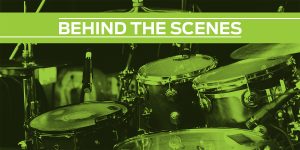BY PHIL HOOD
This past winter I started hearing a question from my gossipy drum industry friends: “What do you think will happen to Slingerland?” Gibson Guitar Corporation, owner of the Slingerland name, was on financial death watch as it was weighed down with debt. The future of the many brands it owns, especially a legendary name like Slingerland, was uncertain. Now that Gibson has filed for Chapter 11 bankruptcy, the guessing game shifts into high gear.
 Gibson will be reorganized and is likely to shed a lot of assets. According to the official press announcement, the company will shrink by getting rid of the many electronic businesses it has acquired, including headphones from Phillips, recorders from Tascam, and others. Then it will be able to focus on its guitar business again. It also has to shed debt, which is estimated somewhere in the $100 million to $500 million range. “Gibson will emerge from Chapter 11 with working capital financing, materially less debt, and a leaner and stronger musical instruments-focused platform,” the company says.
Gibson will be reorganized and is likely to shed a lot of assets. According to the official press announcement, the company will shrink by getting rid of the many electronic businesses it has acquired, including headphones from Phillips, recorders from Tascam, and others. Then it will be able to focus on its guitar business again. It also has to shed debt, which is estimated somewhere in the $100 million to $500 million range. “Gibson will emerge from Chapter 11 with working capital financing, materially less debt, and a leaner and stronger musical instruments-focused platform,” the company says.
Lazarus or ‘Walking Dead’?
But what of Slingerland? Now that it may be extricated from Gibson, what do its possible futures look like? I see three options for the management at Gibson. They could:
- Sell the name and the assets.
- License the name for manufacturing by others.
- Keep it and begin manufacturing drums
I talked to about a dozen people the week to see what they think. This makeshift panel included including collectors and vintage experts, drum builders, company presidents, and suppliers, including some people who worked for Slingerland long ago. They are divided as to whether the company will sell it or perhaps license it, though no one knows anything for sure. One president of a top drum company said “[The new management will] do everything they can to pay off debts, stabilize the business and make it profitable. I would assume that would mean selling the Slingerland name as an asset.” He added that he didn’t see much there, saying, “The value has been drawn out of Slingerland like the blood from a vampire’s victim.”

Others disagree, if only slightly. Rob Cook, author of The Slingerland Book says that in his experience Slingerland has far more fans around the world than Rogers Drums had, even though he thinks Rogers made better drums originally. Since Rogers’ recent re-introduction to the market was so well received, that bodes well for anyone hoping to capitalize on Slingerland’s past glory.” He believes there is demand for parts and drums, if they’re made well. Jim Moritz of Chicago Drum, who makes Slingerland-inspired drums today, agrees, but emphasizes that no one knows for sure what will happen at this point.
One person speculated that there may be an insider sale. Past and current employees and managers are often buyers in situations like this, especially of assets with good potential.
Cook also thinks licensing is an option. After Gretsch licensed its drums they were made in Asia and in the US factory in South Carolina. It’s been good for the brand, the drums, and the customers.
I predict that keeping Slingerland is not an option. Some insiders have told me that the company will sell every one of its brands except Gibson and Epiphone. Starting manufacturing drums again is risky; selling it off is a sure thing. The last time great drums were made under the Slingerland name was when Gibson was building them in Nashville in the mid-‘90s. Industry veterans Sam Bacco, Pat Foley, and Dendy Jarrett were involved and artists such as Tré Cool and Taylor Hawkins (who was playing with Alanis Morrissette at the time) were highly visible endorsers. Drum collector Donn Bennett, who is a DRUM! Magazine columnist, asserts, “Those are some of the best drums ever made.”

Buddy Rich’s 1970s Slingerland kit. Photo courtesy of Donn Bennett.
Slingerland’s Long History
Slingerland was started by H.H. Slingerland in 1912. He’d won a music school in a card game in one of the gambling boats that cruised Lake Michigan. Shortly after that he began importing and selling ukuleles, and soon began manufacturing them, and banjos, too. In 1927 Slingerland started making drums, partly in response to the Ludwig & Ludwig company entering the banjo market.
The brand was successful during the heights of the jazz age with top players and endorsers such as Buddy Rich and Gene Krupa. The flagship product was the Radio King snare, a steambent solid maple drum that stood out in contrast to the mahogany ply drums of the day.
The company continued in the family until 1970 and had a strong position with marching bands and drum set players into the ‘80s. Top artists such as Peter Erskine (Weather Report), Artimus Pyle (Lynrd Skynrd), Phil Ehard (Kansas), and Danny Seraphine (Chicago) were among Slingerland artists. The company began changing hands around that time, ultimately being purchased by Gibson. Despite the brief period of success under Gibson’s leadership, there were many corporate missteps and lack of clear commitment to the brand. One ex-Gibson marketer recalls a meeting at which clueless management asked, “Why do drummers need all those sizes [referring to toms]? Just make one kit in one size. That’s all we need.” That would make quite a tombstone, wouldn’t it?
